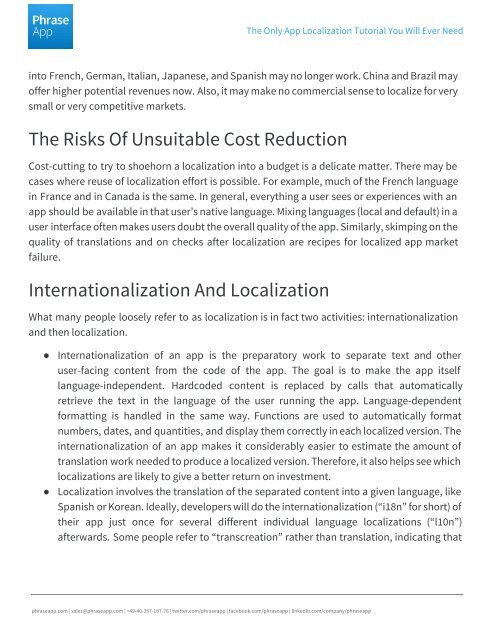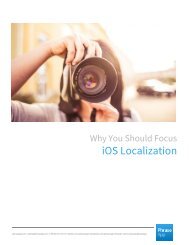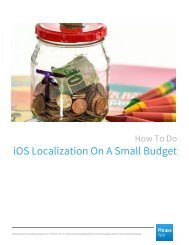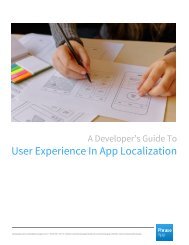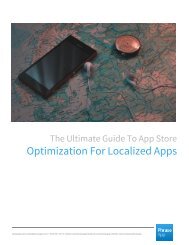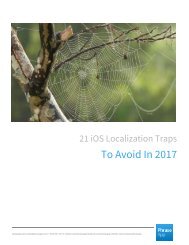The Only App Localization Tutorial You Will Ever Need
Create successful ePaper yourself
Turn your PDF publications into a flip-book with our unique Google optimized e-Paper software.
<strong>The</strong> <strong>Only</strong> <strong>App</strong> <strong>Localization</strong> <strong>Tutorial</strong> <strong>You</strong> <strong>Will</strong> <strong>Ever</strong> <strong>Need</strong><br />
into French, German, Italian, Japanese, and Spanish may no longer work. China and Brazil may<br />
offer higher potential revenues now. Also, it may make no commercial sense to localize for very<br />
small or very competitive markets.<br />
<strong>The</strong> Risks Of Unsuitable Cost Reduction<br />
Cost-cutting to try to shoehorn a localization into a budget is a delicate matter. <strong>The</strong>re may be<br />
cases where reuse of localization effort is possible. For example, much of the French language<br />
in France and in Canada is the same. In general, everything a user sees or experiences with an<br />
app should be available in that user’s native language. Mixing languages (local and default) in a<br />
user interface often makes users doubt the overall quality of the app. Similarly, skimping on the<br />
quality of translations and on checks after localization are recipes for localized app market<br />
failure.<br />
Internationalization And <strong>Localization</strong><br />
What many people loosely refer to as localization is in fact two activities: internationalization<br />
and then localization.<br />
● Internationalization of an app is the preparatory work to separate text and other<br />
user-facing content from the code of the app. <strong>The</strong> goal is to make the app itself<br />
language-independent. Hardcoded content is replaced by calls that automatically<br />
retrieve the text in the language of the user running the app. Language-dependent<br />
formatting is handled in the same way. Functions are used to automatically format<br />
numbers, dates, and quantities, and display them correctly in each localized version. <strong>The</strong><br />
internationalization of an app makes it considerably easier to estimate the amount of<br />
translation work needed to produce a localized version. <strong>The</strong>refore, it also helps see which<br />
localizations are likely to give a better return on investment.<br />
● <strong>Localization</strong> involves the translation of the separated content into a given language, like<br />
Spanish or Korean. Ideally, developers will do the internationalization (“i18n” for short) of<br />
their app just once for several different individual language localizations (“l10n”)<br />
afterwards. Some people refer to “transcreation” rather than translation, indicating that<br />
phraseapp.com | sales@phraseapp.com | +49-40-357-187-76 | twitter.com/phraseapp | facebook.com/phraseapp | linkedin.com/company/phraseapp


